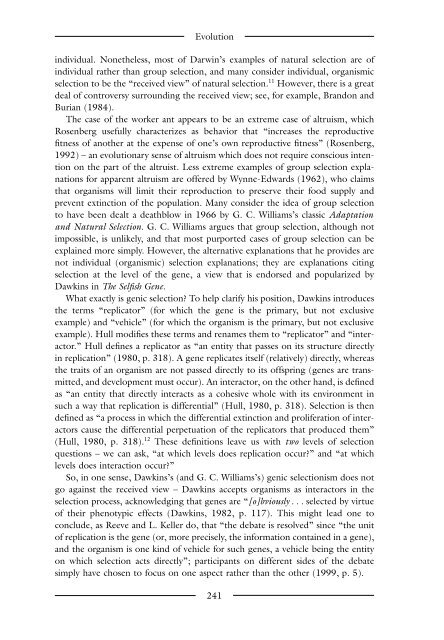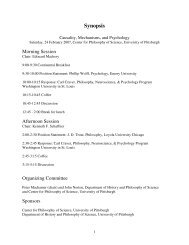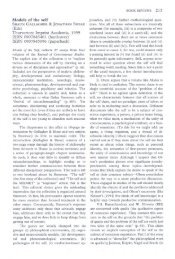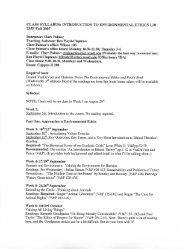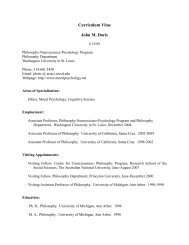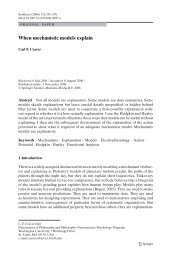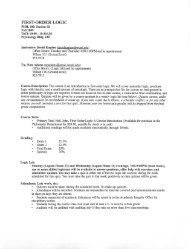The Blackwell Guide to the Philosophy of Science - The Department ...
The Blackwell Guide to the Philosophy of Science - The Department ...
The Blackwell Guide to the Philosophy of Science - The Department ...
Create successful ePaper yourself
Turn your PDF publications into a flip-book with our unique Google optimized e-Paper software.
Evolution<br />
individual. None<strong>the</strong>less, most <strong>of</strong> Darwin’s examples <strong>of</strong> natural selection are <strong>of</strong><br />
individual ra<strong>the</strong>r than group selection, and many consider individual, organismic<br />
selection <strong>to</strong> be <strong>the</strong> “received view” <strong>of</strong> natural selection. 11 However, <strong>the</strong>re is a great<br />
deal <strong>of</strong> controversy surrounding <strong>the</strong> received view; see, for example, Brandon and<br />
Burian (1984).<br />
<strong>The</strong> case <strong>of</strong> <strong>the</strong> worker ant appears <strong>to</strong> be an extreme case <strong>of</strong> altruism, which<br />
Rosenberg usefully characterizes as behavior that “increases <strong>the</strong> reproductive<br />
fitness <strong>of</strong> ano<strong>the</strong>r at <strong>the</strong> expense <strong>of</strong> one’s own reproductive fitness” (Rosenberg,<br />
1992) – an evolutionary sense <strong>of</strong> altruism which does not require conscious intention<br />
on <strong>the</strong> part <strong>of</strong> <strong>the</strong> altruist. Less extreme examples <strong>of</strong> group selection explanations<br />
for apparent altruism are <strong>of</strong>fered by Wynne-Edwards (1962), who claims<br />
that organisms will limit <strong>the</strong>ir reproduction <strong>to</strong> preserve <strong>the</strong>ir food supply and<br />
prevent extinction <strong>of</strong> <strong>the</strong> population. Many consider <strong>the</strong> idea <strong>of</strong> group selection<br />
<strong>to</strong> have been dealt a deathblow in 1966 by G. C. Williams’s classic Adaptation<br />
and Natural Selection. G. C. Williams argues that group selection, although not<br />
impossible, is unlikely, and that most purported cases <strong>of</strong> group selection can be<br />
explained more simply. However, <strong>the</strong> alternative explanations that he provides are<br />
not individual (organismic) selection explanations; <strong>the</strong>y are explanations citing<br />
selection at <strong>the</strong> level <strong>of</strong> <strong>the</strong> gene, a view that is endorsed and popularized by<br />
Dawkins in <strong>The</strong> Selfish Gene.<br />
What exactly is genic selection? To help clarify his position, Dawkins introduces<br />
<strong>the</strong> terms “replica<strong>to</strong>r” (for which <strong>the</strong> gene is <strong>the</strong> primary, but not exclusive<br />
example) and “vehicle” (for which <strong>the</strong> organism is <strong>the</strong> primary, but not exclusive<br />
example). Hull modifies <strong>the</strong>se terms and renames <strong>the</strong>m <strong>to</strong> “replica<strong>to</strong>r” and “interac<strong>to</strong>r.”<br />
Hull defines a replica<strong>to</strong>r as “an entity that passes on its structure directly<br />
in replication” (1980, p. 318). A gene replicates itself (relatively) directly, whereas<br />
<strong>the</strong> traits <strong>of</strong> an organism are not passed directly <strong>to</strong> its <strong>of</strong>fspring (genes are transmitted,<br />
and development must occur). An interac<strong>to</strong>r, on <strong>the</strong> o<strong>the</strong>r hand, is defined<br />
as “an entity that directly interacts as a cohesive whole with its environment in<br />
such a way that replication is differential” (Hull, 1980, p. 318). Selection is <strong>the</strong>n<br />
defined as “a process in which <strong>the</strong> differential extinction and proliferation <strong>of</strong> interac<strong>to</strong>rs<br />
cause <strong>the</strong> differential perpetuation <strong>of</strong> <strong>the</strong> replica<strong>to</strong>rs that produced <strong>the</strong>m”<br />
(Hull, 1980, p. 318). 12 <strong>The</strong>se definitions leave us with two levels <strong>of</strong> selection<br />
questions – we can ask, “at which levels does replication occur?” and “at which<br />
levels does interaction occur?”<br />
So, in one sense, Dawkins’s (and G. C. Williams’s) genic selectionism does not<br />
go against <strong>the</strong> received view – Dawkins accepts organisms as interac<strong>to</strong>rs in <strong>the</strong><br />
selection process, acknowledging that genes are “[o]bviously . . . selected by virtue<br />
<strong>of</strong> <strong>the</strong>ir phenotypic effects (Dawkins, 1982, p. 117). This might lead one <strong>to</strong><br />
conclude, as Reeve and L. Keller do, that “<strong>the</strong> debate is resolved” since “<strong>the</strong> unit<br />
<strong>of</strong> replication is <strong>the</strong> gene (or, more precisely, <strong>the</strong> information contained in a gene),<br />
and <strong>the</strong> organism is one kind <strong>of</strong> vehicle for such genes, a vehicle being <strong>the</strong> entity<br />
on which selection acts directly”; participants on different sides <strong>of</strong> <strong>the</strong> debate<br />
simply have chosen <strong>to</strong> focus on one aspect ra<strong>the</strong>r than <strong>the</strong> o<strong>the</strong>r (1999, p. 5).<br />
241


